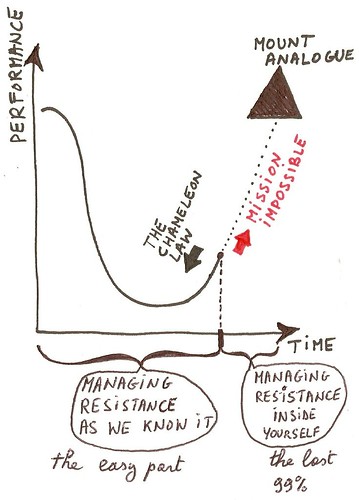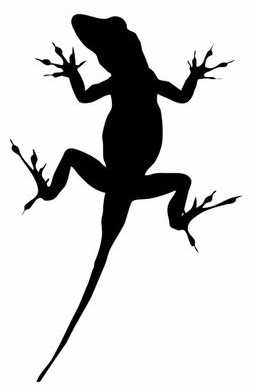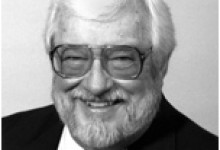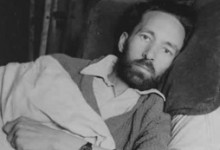Most of us have two lives. The life we live, and the unlived life within us. Between the two stands Resistance.
Steven Pressfield
Coming to terms with the very ‘resistance’ I have been studying and writing about for the last few years: it is all about the same thing. It is all about me, myself and I. And that’s bad news for my ego.
Chameleon Law
Earlier I have mentioned the 1944 unfinished novel Mount Analogue by René Daumal. It describes the travel of a company of eight, who set sail in the yacht Impossible to search for Mount Analogue, a solid, a geographical place that “cannot not exist.”
The story of Mount Analogue is about making something happen that all people around you say is impossible and ridiculous. In this novel about the expedition to a mythical mountain that reaches from earth to heaven, Daumal mentions the chameleon law, which he describes as the inner resonance to influences nearest at hand (“la résonance aux plus proches affimations” if you happen to speak French). As the protagonist of this tale is in the vulnerable starting phase of this expedition, he discovers how he is prone to social pressure and how difficult it is to commit to something before knowing how.
Amygdala
Mount Analogue is about inner doubts and how they prevent us from seeing the other 99% of the possibilities that are at hand in each situation. With rational thinking and conventional ‘common sense’ we easily fall prey to the chameleon law. Scratch off the surface of the chameleon and you will find Fear driving its actions.
The chameleon law as it was coined in 1944 by Daumal didn’t go mainstream until Daniel Goleman – more than 50 years later – published Emotional Intelligence.
All of a sudden the reptile brain – also known as the amygdala – went mainstream. The amygdala plays a key part in our fight-flight responses to unpleasant sights, sensations, or smells. A great part of our basic instincts such as anger and anxiety are emotions activated by the amygdala.
Lizard Brain
But it is only until recently that the functioning of this reptile part of our brain has been translated in terms of organizational change.
In his latest book Linchpin Seth Godin refers to the chameleon law as the voice in the back of our head telling us to back off, be careful, go slow, compromise. He calls it the lizard brain. It is writer’s block and every project that ever shipped late because people couldn’t stay on the same page long enough to get something out the door.
He uncovers the lizard brain as the motor of mediocrity and the main responsible for late launches, middle of the road products and procrastination. It is the force that causes you to fit in instead of standing out.
Redefining Resistance
Godin got the inspiration for the lizard brain from Steven Pressfield – who refers to it as “the resistance”. Hereby Pressfield radically redefines the term resistance by taking it from a general condition that can easily be diagnosed in other people to the identification of a force we all have to struggle with.
In his book The War of Art: Break Through the Blocks and Win Your Inner Creative Battles
, Pressfield states:
“Resistance seems to come from outside of ourselves. We locate it in our spouses, jobs, bosses, kids.”
But in truth, as he continues:
“Resistance arises from within. It is self-generated and self-perpetuated. Resistance is the enemy within.”
The Moral for Organizational Change
Organizational change projects are mostly about creating a situation that does not yet exist. A situation, a project or any other expedition is “talked into existence”. With every word you speak, a seed is planted that can give birth to a new reality. Karl Weick refers to this as the process of Enactment to denote that certain phenomena (such as this crazy expedition, or your own project for that matter!) are created by being talked about.
Slowly but surely – if you are persistent enough – your ideas translate to words, your words translate to actions and our actions result into tangible outcomes.

The lizard-type of resistance is the biggest enemy during organizational change efforts, because you are shaping the path for a future that has no gravity in the present.
As you can see from the drawing, the classic way of managing resistance will only get you half way. The last part of the change curve is about fighting the chameleon law from taking over.
Turning Pro
You have to be crazy enough and stubborn enough to endeavor your objectives against all odds of the chameleon law.
It is the very process of setting one foot in front of another and then: keep on climbing. Steven Pressfield calls this turning pro:
“The amateur believes he must first overcome his fear; then he can do his work. The professional knows that fear can never be overcome. He knows there is no such thing as a fearless warrior or a dread-free artist”
An organizational change project is a mountaineering expedition of the inner mind as much as it is about delivering a project according to a certain methodology. It is as much an organizational process (Managing resistance as we know it) as it is an inner struggle for fueling our own commitment to an expedition with an un-rational (i.e. ‘rationally ‘unreachable’) objective (Managing resistance inside yourself).
But the hardest part of the battle is inside our own heads. It’s the ability to pursue a dream.







Pingback: Unraveling Social Interaction (Part 3) | Reply-MC()